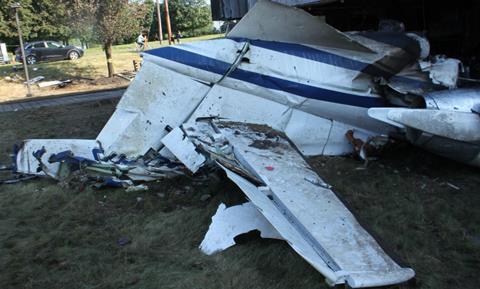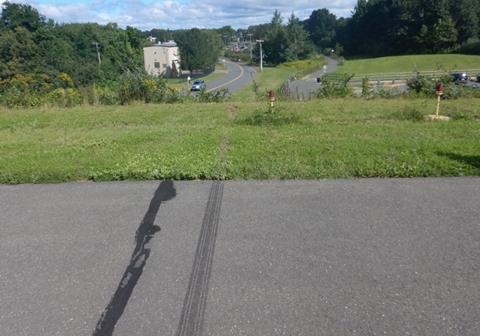US investigators have determined that the pilots of a Cessna Citation 560 XLS+ failed to release the aircraft’s parking-brake before it overran the runway on take-off, pitching rapidly up before rolling inverted and crashing into a building.
None of the four occupants survived the accident which occurred as the jet (N560AR) attempted to depart Farmington’s Robertson Field airport in Connecticut on 2 September 2021.
Frictional force from the engaged parking-brake not only reduced the jet’s acceleration on the runway but also acted to oppose the elevator, creating a pitch-down moment, says the National Transportation Safety Board.
As the captain, who was flying, attempted to rotate at 104kt the cockpit-voice recorder captured sounds of straining, suggesting the pilot was trying to pull the control yoke without any response from the aircraft.
The jet failed to lift off and overran the runway. Although the aircraft remained level, the terrain dipped sharply, by 20-25ft, off the runway end, which suddenly meant the wheels were no longer in ground contact. The resulting immediate loss of braking force caused the jet to respond instantly to the heavy aft yoke command.
It immediately pitched to 22° nose-up in less than 2s and the rapid change of attitude triggered a stall warning and stick-shaker activation as well as a nose-down elevator input.

A witness observed the right engine strike a pole past the runway departure end, and the thrust from this engine began to decline even though the thrust lever positions remained unchanged.
The aircraft started rolling to the right and inverted in around 3.5s, before striking the ground and then an occupied building.
According to the cockpit-voice recorder, the pilots verbalised items from the ‘before take-off’ checklist. But there was no challenge response for this checklist, or those for taxi and take-off.
“No crew briefing was performed and neither pilot mentioned releasing the parking-brake,” says the inquiry, adding that the flight-data recorder showed no evidence of a flight-control movement check.
The take-off checklist included an item for ‘brake release’, although it did not specifically indicate ‘parking-brake release’.
While a “specific and unambiguous” checklist item to verify parking-brake release might have helped crews to perform this task consistently, the inquiry says this is “unlikely” to have prevented the Farmington accident given the absence of challenge responses.
It points out that the position of the parking-brake knob meant it could not be seen by the pilot in the right-hand seat, underlining the importance of the checklist procedure. Parking-brake status was neither indicated nor annunciated in the cockpit, and was not part of a configuration warning system.

Performance analysis showed that – at the point of rotation speed – the nose-down pitch moment caused by the adverse braking force was over 16,800Nm, some 77% greater than the nose-up pitch moment capability of the elevator and horizontal stabiliser.
For speeds beyond this rotation point a successful take-off would have required a nose-up pitch moment capability which “exceeded the [aircraft’s] certified envelope”, says the inquiry.
Investigators highlighted two similar occurrences as part of the accident probe – a September 2015 rejected take-off and overrun involving a Cessna 550 in Lismore, Australia, and a rejected take-off and wheel fire in Bauchi, Nigeria, in October 2018 with a Cessna 560 XLS+ operated by the Nigerian police.
In both cases the pilots did not fully release the parking-brake before departure. After the Lismore accident, the manufacturer rejected a recommendation for parking-brake annunciation, stating that releasing the brake before take-off was “simple airmanship”.


























